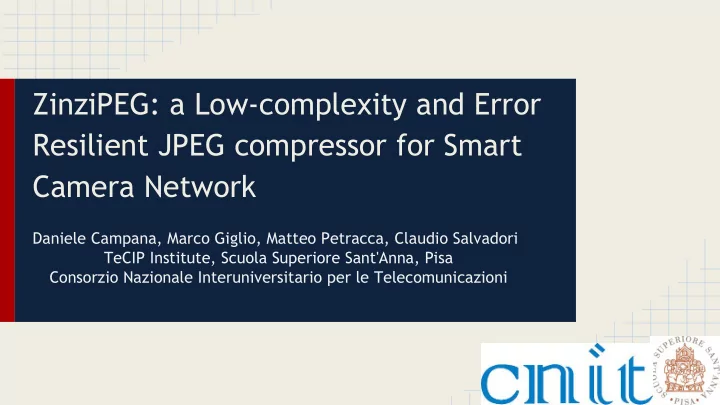

ZinziPEG: a Low-complexity and Error Resilient JPEG compressor for Smart Camera Network Daniele Campana, Marco Giglio, Matteo Petracca, Claudio Salvadori TeCIP Institute, Scuola Superiore Sant'Anna, Pisa Consorzio Nazionale Interuniversitario per le Telecomunicazioni
Main goal and environment To develop a video coder with two main features: ● High compression level; ● High error resilience properties on wireless channels. The considered environment: ● IEEE802.15.4 compliant networks ● Low-rate networks; ● High bit error rate values.
JPEG: working principles The JPEG standard is based on: ● Discrete Cosine Transform (DCT) ● Huffman encoding (loss-less entropy encoding)
JPEG example 8x8 pixel block
Discrete Cosine Transform
Quantization
Zig Zag re-ordering −26 −3 0 −3 −2 −6 2 −4 1 −3 1 1 5 1 2 −1 1 −1 2 0 0 0 0 0 -1 -1 0 0 0 0 0 0 0 0 0 0 0 0 0 0 0 0 0 0 0 0 0 0 0 0 0 0 0 0 0 0 0 0 0 0 0 0 0 0
Huffman Encoding ● Lossless data compression: ○ Entropy encoding ○ Can be seen as a variable-length code table for encoding a source symbol (such as a character in a file) ○ The more common symbols are generally represented using fewer bits than less common symbols
JPEG advantages ● Good compression level ○ Compression quality ranging form 1 to 100 ○ Ratio between quality and size variable from image to image. ● JPEG is largely adopted
JPEG disadvantages ● The image header dimension is very big ○ It embeds quantization tables, huffman tables, etc… ○ ~500 bytes. ● No error resiliency properties ○ Error in the header: the decoding might converge to wrong results or it might fail. ○ Error in the data: decoding failure or wrong decoding ○ DC of blocks is correlated: the errors are propagated to following blocks
The ZinziPEG ZinziPEG is based on an integer JPEG compressor written in C. We performed several modifications in order to achieve the desired goals: ● markers ● header remotion ● packetization (oriented to IEEE802.15.4 standard) ● recovery and concealment on receiver side
The ZinziPEG Encoder It implements: ● Header remotion ○ Removed about 500bytes (great impact in low quality images) ● Packetization (oriented to IEEE802.15.4 standard) ● Trailer ● Markers insertion
Header removal ● The JPEG header is very big (~500 bytes) ● The CODEC parameters (quantization tables, huffman tables, etc…) are set in the init-phase ○ Improve the compression ○ Improve the resiliency Error in the header: it is impossible to decode the image!!
Packet fragmentation ● An integer number of block in each data packet ○ The first block of each packet is a safe point ○ If a packet is lost, the next one can be easily decoded ● The available payload in 802.15.4 networks is only 104 bytes. ● Each packet contains an applicative trailer to describe what the system is transmitting ○ Protected by using a FEC tecnique (Hamming Code (40,7))
The packet trailer R FLAGS LAST_BLOCK NUM_BLOCKS NUM_BITS 1 2 13 7 10 R 1 reserved bit FLAGS 2 bits used for fragmentation purposes LAST_BLOCK 13 bits containing the id of the last 8x8 block wich has been inserted in the packet. NUM_BLOCKS 7 bits to represent the number of blocks contained in this packet. NUM_BITS 10 bits representing the lenght of the zero padding
Standard JPEG markers ● Standard JPEG mechanism: ○ 2 bytes markers inserted every n blocks ○ used to decorrelate the DC, to repair block alignment and a safe start point to start reading whenever an error is encounter during Huffman decoding ○ If 9 consecutive markers are lost, the decompression fails
The ZinziPEG markers ● ZinziPEG mechanism: ○ provide DC decorrelation and safe start point (as JPEG); ○ markers are only 1 byte long (less memory overhead) ○ The use of both markers and trailers allows stronger resiliency ■ removed the constraints on the number of consecutive markers that can get lost
The ZinziPEG decoder ● The ZinziPEG decoder translate the encoded image in standard JPEG ○ Corrects errors due to noise on the channel (by using the FEC decoder) ○ Reconstruct the image and add the JPEG standard header ○ “Grey concealment” is performed whenever there is a corrupted block ● The ZinziPEG decoder ALWAYS returns a correct JPEG image, but of course some of its blocks might be corrupted (bit-flips on the DCT coefficients) or replaced with grey ones (grey concealment). ● JPEG might not converge in case of bit flips
Experimental setup ● Comparison between ZinziPEG with standard JPEG (with markers) ● Experiments on simulated channels with high BERs (i. e., BER = 5e-2) ● Metrics: ● compressed image size (bytes); ● quality of the received images (SSIM).
Structural SIMilarity index S-SIM “ is a method for measuring the similarity between two images. The SSIM index can be viewed as a quality measure of one of the images being compared, provided the other image is regarded as of perfect quality .” Z. Wang, A. C. Bovik, H. R. Sheikh and E. P. Simoncelli, "Image quality assessment: From error visibility to structural similarity," IEEE Transactions on Image Processing, vol. 13, no. 4, pp. 600-612, Apr. 2004.
Image size Low quality: ZinziPEG might even outperform JPEG thanks to the reduced overhead due to header remotion. Medium quality: ZinziPEG files are only slightly bigger than JPEG ones. High quality: ZinziPEG requires much more space than JPEG due to the increased number of trailers to be sent.
Quality comparison (JPEG)
Quality comparison (ZinziPEG)
Conclusions ● JPEG-like compressed image size ● Huge error resiliency improvement ● Simple implementation, suitable for micro-controllers based embedded systems ○ Suitable for micro-controllers W/O FPU, since the integer implementation
Recommend
More recommend